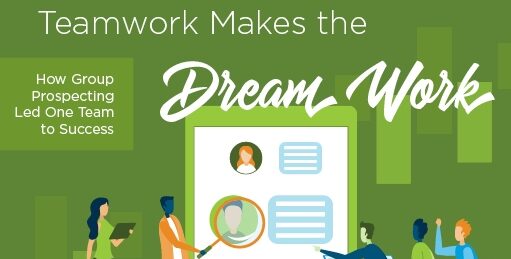By Jessica Lirette, University of New Hampshire and Shay Laderbush, The Munshine Group
Working as a group can be a productive and efficient use of time, resources and skills. Over the last few years, the prospect research and management team at the University of New Hampshire has streamlined a process to quickly identify potential prospects from large data lists. The process, known as “group prospecting,” can be adapted to fit a variety of objectives, and has yielded a high number of prospects, as well as improved our relationships with our development and alumni relations colleagues. It can also be a fun way to break up the day and bring the team together.
Success didn’t come overnight, and we initially struggled to find our footing. A team member had attended a conference session on group work and wanted to try writing donor profiles as a team. Our researchers gathered in a room to collectively research and write individual prospect profiles, then determine capacity ratings. It could have been the complexity of the prospects, the team dynamics, or an unfamiliarity with the process, but we struggled to unify our different voices to tackle the robust and specific profiles. We quickly tabled the practice.
Months later, our team was approached regarding event lists. As the alumni relations team organized events, they discussed the RSVP lists with development officers to ensure each attendee had a touchpoint with a fundraiser. Our team quickly realized this would be an excellent opportunity to try group work again, but with a very different objective than before. We would review the unassigned attendees and alert the development team of promising major gift leads with whom they should establish relationships at the event. These prospects were already warm, so our team simply highlighted those with capacity and identified whether they were a good fit for a particular college, or our planned giving, annual giving, or alumni relations teams.
We received overwhelmingly positive feedback from this exercise, and were able to adapt this group prospecting model to review the development team’s portfolios. Using key data points, we helped gift officers prioritize their individual portfolios to give attention to those with the highest capacity, affinity and inclination. This exercise helped reduce inflated portfolios and showed, again, how prospect research and management can support fundraising efforts by concentrating on the top prospects. These sessions aren’t designed to write full profiles or research individuals in depth, but to take a large list and highlight the best prospects.
When To Engage in Group Prospecting
Over time, we realized that we could adapt the group prospecting method for even more situations, including to:
- Boost prospects for a specific unit or fundraising priority
- Highlight prospects from the weekly giving report
- Identify top-scoring prospects from a wealth screening
- Build campaign gift tables and further assess prospects throughout our campaign
How To Engage in Group Prospecting
It is important to be organized throughout this process. It can be fairly simple by just following these steps:
- Block off time in advance. You’ll want to reserve one to two hours, typically, depending on the size of the list. Prepare to give a few minutes for each prospect, and schedule multiple meetings if necessary. If you have the time and resources, you can schedule regular weekly or monthly gatherings where your team is dedicated to this task.
- Pull together a shared spreadsheet with relevant information: database ID, name, giving history, ratings, notes, anything else you can put together to get started. If you’re short on time, try to prioritize the list the best you can so that you get through the most urgent or exciting prospects.
- Gather together. Group prospecting is most successful when you are all in one place so you can have quick conversations or discuss strategy. You can still do this in the virtual environment over Zoom or other video conferencing services.
- Assign duties (based on the size of the team).
- Database reviewer: Checks giving details, verifies information and reads contact notes for past history
- Paid resources researcher: Utilizes paid subscriptions to locate real estate and other asset information, as well as philanthropic gifts
- Social media researcher: Reviews Facebook, LinkedIn and other social media sites for biographic updates, family details and other wealth indicators
- Recorder: Adds comments and the final recommendation to the notes column in the shared spreadsheet; submits research tickets as necessary
- Data entry specialist: Makes real-time changes in the database
- General Googler: Uses Google for news articles, obituaries and whatever else may appear ― all team members usually end up doing this
- Start group prospecting. Work your way down the list, with team members talking freely about what each has found. Conversations and discussions are good! Then, come to a unanimous, or near unanimous, decision on the next step. Are they someone a development officer should meet at the event? Are they worthy of first pass research? Should they be removed from the portfolio?
- Share your findings. This step will vary depending on the objective of your prospecting. For event prospecting, we sent a detailed email to the development and alumni relations teams, clearly outlining our proposed prospects and why we thought they were appropriate.
High-Level Tips for Group Prospecting
- Remember your objective. Because group prospecting can be adapted for a variety of different goals, don’t forget why you are prospecting for that particular project. Depending on your objective, you may think differently about the importance of certain data points.
- Be flexible. If team members are out, make do with who you have.
- Allow for breaks and snacks. Two hours can be a long time. Schedule in breaks to ensure conversations don’t fizzle out.
- Keep the atmosphere fun and light. Play music, and encourage the occasional rabbit hole if the team needs a break. We’re big fans of casting our computers on the big screen if we see something particularly interesting.
Variations on Group Prospecting for Any Team
Group prospecting was designed for a team of researchers, but can be adapted to fit the size and makeup of almost any team. If you are the only researcher, bring in your data entry colleague or a frontline fundraiser. This could be a great opportunity to all learn from each other. The idea behind this effort is that many hands make light work. Additionally, you can reconfigure group prospecting to work even in remote settings. Through Zoom or other video conferencing tools, you can virtually replicate the scene from your office or conference room. Our team has also tried posting names on Microsoft Teams, with our researchers chiming in with our quick evaluations about their next steps.
We have found group prospecting to be an incredibly useful tool, and we are pleased with how our colleagues have reacted to our results. Additionally, we have identified so many new and promising prospects that we created a new product and process to accommodate the increased work. We have also enjoyed many laughs, and look forward to the day when we can once again gather in the conference room.
Editor’s Note: Prior to joining The Munshine Group as vice president, Shay Laderbush was the prospect research and management analyst at the University of New Hampshire where she worked with Jessica Lirette, prospect research analyst, and helped establish this group prospecting technique.


